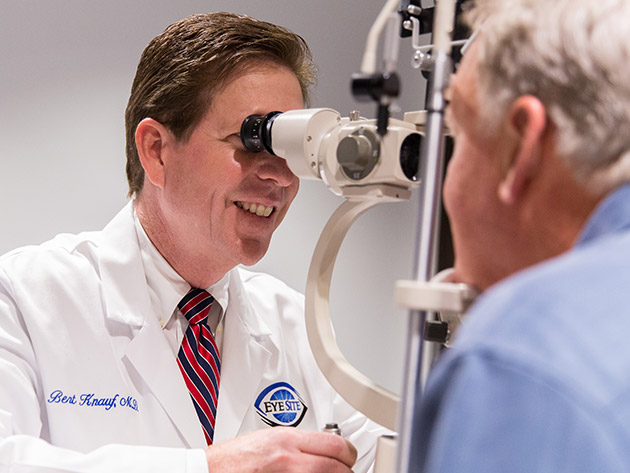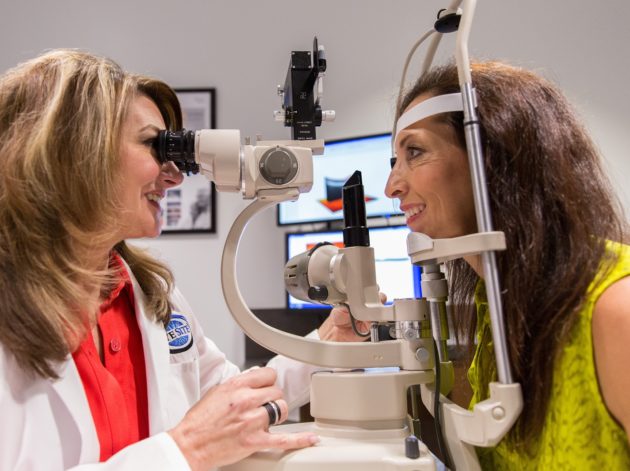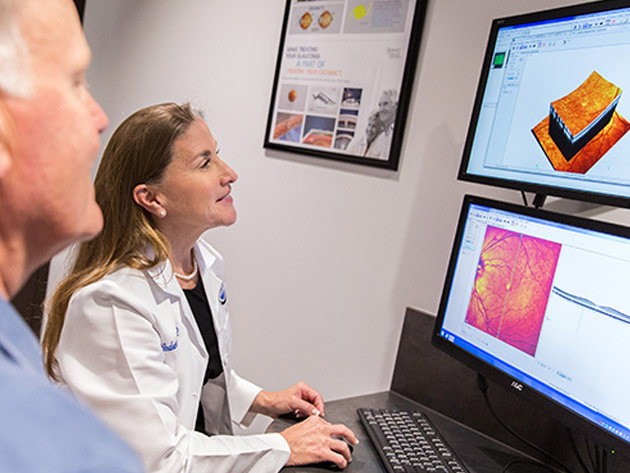Eye Conditions

Cataracts
Cataracts occur when the natural lens of the eye becomes cloudy, causing things to look blurry, hazy, or less colorful. Aging is the most common cause of cataracts, and they typically develop slowly. Protecting your eyes from the sun’s ultraviolet (UV) light rays by wearing sunglasses may slow down the development of cataracts.
The good news is that cataract surgery is a safe and effective procedure. While the procedure is normally done completely manually, we are proud to offer our patients a premium option: advanced, laser-assisted surgery with the VICTUS® and LenSx® femtosecond laser platforms. This state-of-the-art technology is designed to provide maximum surgical precision and patient comfort during the procedure. The surgery involves replacing the cloudy natural lens with a clear artificial lens called an intraocular lens (IOL). You should consider cataract surgery when the symptoms of cataracts keep you from doing your daily activities. and LenSx® femtosecond laser platforms. This state-of-the-art technology is designed to provide maximum surgical precision and patient comfort during the procedure. The surgery involves replacing the cloudy natural lens with a clear artificial lens called an intraocular lens (IOL). You should consider cataract surgery when the symptoms of cataracts keep you from doing your daily activities.

Glaucoma
Glaucoma occurs when the pressure in the eye (intraocular pressure) damages the optic nerve, usually affecting the peripheral vision first, but it can then proceed to permanent blindness.
Glaucoma is often called the sneak thief of sight, because it is usually painless, affects the peripheral vision first, and can be quite severe before the patient is aware of it. It is the leading cause of blindness for people over 60 years old. Any vision loss is permanent, so regular eye check-ups and early treatment can greatly reduce your risk of blindness from glaucoma. Ophthalmologists treat glaucoma with medicine, lasers, and surgery.

Macular Degeneration
Age-related macular degeneration is the deterioration of the central portion of the retina, known as the macula. Since the macula controls the central vision of the eye, it can cause great difficulty with reading, focusing on objects, color vision, and driving a car.
Macular degeneration is now affecting the population more than cataracts and glaucoma combined. Due to the aging of the US population, macular degeneration is the leading cause of vision loss. Your risk of having macular degeneration starts to increase around the age of 50 years old. Macular degeneration is largely genetic in origin and can also be associated with other factors such as smoking, obesity, high blood pressure, and long-term exposure to sunlight without proper eye protection.

Diabetic Retinopathy
Diabetic retinopathy, the most common diabetic eye disease, occurs when blood vessels in the retina undergo deterioration due to poorly controlled blood sugar. Sometimes these vessels leak fluid and blood or even close off completely. In other cases, abnormal new blood vessels grow on the surface of the retina.
Diabetic retinopathy usually affects both eyes, but may be worse in one eye. People who have diabetic retinopathy often don’t notice changes in their vision in the disease’s early stages. As it progresses, diabetic retinopathy usually causes vision loss that in many cases is severe and cannot be reversed. Maintaining strict control of blood sugar and blood pressure, as well as having regular diabetic retinopathy exams, are keys to preventing vision loss.
If treatment is needed, there are now more alternatives available. The most common forms of treatments are intravitreal injections followed by drops, laser, and surgery.

Corneal Disease or Injury
A healthy, clear cornea is necessary for good vision. If your cornea is injured or affected by disease, it may become swollen or scarred, and its smoothness and clarity may be lost. Scars, swelling, or an irregular shape can cause the cornea to scatter or distort light, resulting in glare or blurry vision.
Corneal transplantation is a surgery that replaces a damaged or diseased cornea with a healthy donor cornea. If your cornea cannot be healed or repaired, your ophthalmologist may recommend a corneal transplant.
Sometimes a partial thickness corneal transplant (DSAEK, DMEK, DALK) can be used to speed recovery and reduce rejection rates.

Dry Eye
“What do you mean my eyes are dry? They water all the time!”
While tearing can be due to several reasons, the most frequent reason is due to Dry Eye Syndrome, which can also be called “Ocular Surface Disease.” This is one of the most frequent causes of eye irritation. When the eyes are irritated, they will start to water. Unfortunately, our reflex tears are not of the same quality as our normal natural tears, so when the eyes start to water, they are not filling the eye with quality tears, and the problem doesn’t go away.
Dry Eye Syndrome can be due to “not enough tears,” “poor quality tears,” or usually a combination of the two.
Your doctor might suggest using preservative-free artificial tears or eye drops that help your eyes make tears. Other treatment options include blocking your tear drainage ducts with tiny plugs or with surgery. This keeps tears in your eyes longer. If you are bothered by dry eye, talk with your doctor for ways to find relief.
